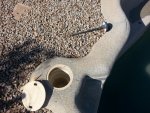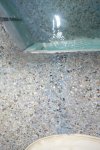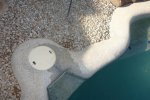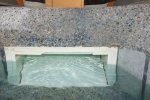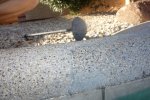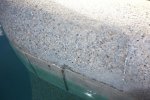- Aug 5, 2013
- 219
- Pool Size
- 12000
- Surface
- Plaster
- Chlorine
- Salt Water Generator
- SWG Type
- Pentair Intellichlor IC-40
I bought a house in April this year with a pool and there were a few cracks/separation in the Pebbletec. Nothing that was going to fall off right away, but it was noticeable. I started the pool all over with all fresh stuff (water, salt, blasted the sides, etc.) so I decided that it'd be a good time to get the Pebbletec repaired while the pool was being scrubbed down and emptied. I hired a guy that was recommended to me and he did the work... but I'm not so sure of the job that was done.
So my question is - what is the standard for Pebbletec repair?
BEFORE: Prior to the work there was a crack going straight down from the skimmer lid to the actual skimmer opening. About 2 feet away there was a crack that was separating from the wall.
AFTER: There is no crack or separation. However, there is a difference between the levels of Pebbletec. On the skimmer part you can clearly see where it was cut out and new placed in. The new is about 2mm more shallow than the rest of the surrounding Pebbletec. On the part that was separated away I can see a definite line all around where it was cut away and then new stuff put in - the level on this is fine.
So for the skimmer part, my issue is just the aesthetics of it.
For the separated part my issue is function - will water/salt/chemicals get in the crack over time and eventually break that piece back off?
I'm not sure if I am being unrealistic or what so I'm asking ya'lls opinion on this issue of what you would expect.
PS - Yes, I already contacted them to come out and see if that is a job they would stand by and vouch for. And if they would if they would give any guarantee on it. They said they would come out and look at it, but have not visited yet.
PS2 - Yes, I understand that this thread probably is worthless without pictures. I am at work (yes, 12:48am) right now and can't take pictures.
So my question is - what is the standard for Pebbletec repair?
BEFORE: Prior to the work there was a crack going straight down from the skimmer lid to the actual skimmer opening. About 2 feet away there was a crack that was separating from the wall.
AFTER: There is no crack or separation. However, there is a difference between the levels of Pebbletec. On the skimmer part you can clearly see where it was cut out and new placed in. The new is about 2mm more shallow than the rest of the surrounding Pebbletec. On the part that was separated away I can see a definite line all around where it was cut away and then new stuff put in - the level on this is fine.
So for the skimmer part, my issue is just the aesthetics of it.
For the separated part my issue is function - will water/salt/chemicals get in the crack over time and eventually break that piece back off?
I'm not sure if I am being unrealistic or what so I'm asking ya'lls opinion on this issue of what you would expect.
PS - Yes, I already contacted them to come out and see if that is a job they would stand by and vouch for. And if they would if they would give any guarantee on it. They said they would come out and look at it, but have not visited yet.
PS2 - Yes, I understand that this thread probably is worthless without pictures. I am at work (yes, 12:48am) right now and can't take pictures.



